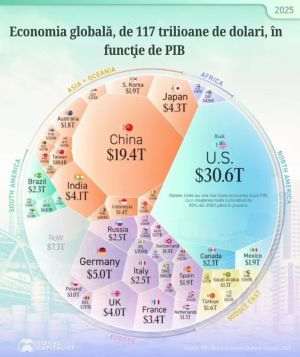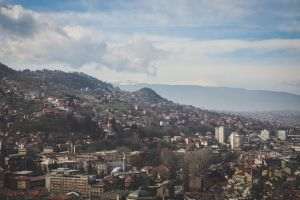As we are nearing the presidential elections in the US, political polarization has reached unprecedented escalation. Why? Where are we going? In order to understand American politics, we need to remember that the American political model is very different from the European one.
American government spending is about 38% of the GDP compared to the EU median of 45% of the GDP, with extremes like France at 55%, and Romania, an emerging market, is still at 36%.
The US is a rich country, with a smaller government sector, but with an economy that is more dynamic than Europe's.
✓ The American model traditionally favors the free market, competition, Schumpeterian "creative destruction" and innovation for companies and industries and accepts more income and wealth inequalities than Europe.
✓ Europe has focused more on stability, on a stronger social "safety net", fewer inequalities and has accepted higher taxes and a slower economy.
In American politics, two traditional parties - Democrat and Republican - have dominated the political scene for more than a century.
✓ In general, democrats have favored more "social justice", the public sector, («Big Government», more business regulation and income redistribution. They are called "Tax-and-Spend Democrats". Their traditional supporters include union workers, public sector workers, companies with interests tied to the public sector. They also tend to attract "minorities", such as for instance people of color, Hispanics ("identity politics"). Academia, mass-media and the legal world are usually democrats. "Green activists" are usually democrats.
✓ Republicans generally favor economic growth, more market freedom, tax frugality and a smaller government.
They believe that a strong economy will generate opportunities for everybody. Their supporters tend to include businesspeople, especially small and medium enterprises. Republicans also include more whites and the Christian groups (very important in the US). What is interesting to note is that there is an increasing number of black and Hispanic Republicans.
From a historical point of view, Democrats and Republicans have always alternated in power, but there has always been a certain bipartisan consensus in American politics. Both parties have sought a centrist movement.
Over the last few years, and in particular under the Trump government, the consensus has eroded, and polarization has become the norm.
There are several fundamental reasons:
The increase in income and wealth inequality. The "We are the 99%" movement which was born a few years ago is a clear demonstration of that. In the last 30-40 years, when the median income of the lower and middle classes stagnated or only barely increased, the "upper class" - business owners, business executives, the financial sector, politicians (including many democrats!), liberal professionals, for instance, doctors or lawyers have become much richer.
This has happened because of the fundamental trends - technological progress, globalization, the shift in the structure of the economy.
✓ Technological progress has eliminated many of the jobs traditionally held by the working class and unionized workers.
✓ Globalization has created millions of jobs in China, Mexico, India and many other emerging markets. Cheaper labor in emerging countries has moved the jobs once held by working class Americans, especially in the industry.
✓ The economic structure has evolved - manufactured and food products are made by a small minority of workers or are imported. Most people work in the services sector, which includes some well paid professions (doctors, computer specialists, for instance), but far more in sectors with far lower pay such as McDonald's and "temporary workers" (Uber drivers for instance). These workers have no union protection and have a very weak social safety net (medical insurance, unemployment etc.).
Politicians can't do much about the above mentioned fundamental trends. Still, they are trying to gain power and as such, they are going by trends and making promises.
Democrats have become more leftist, in hopes of keeping or getting the votes of minorities, newly arrived immigrants and "ethnic citizens". They speak of a world without borders, liberalized immigration, more social safety nets - medical services, public funded college education, green energy and environmental causes etc. Politicians such as socialists Bernie Sanders, Elizabeth Warren and the "team", Ilhan Omar, Rashida Tlaib, Alexandria Ocasio Cortez, have become the new face of the Democratic Party.
Democrats are backed by their traditional supporters and by their business interests tied to globalization, such as Silicon Valley. Mass-media, Academia and the legal profession (which is very big in the US) support Democrats for the most part.
Republicans have their traditional supporters and many new supporters - lower class workers who have been harmed by globalization.
Donald Trump has managed to redraw the political lines by attracting many voters who would normally vote Democrat, such as workers that have suffered following the shifting of jobs to China or Mexico.
Trump, despite his many mistakes, has correctly focused on many key problems, such as economic competition with China, the need to cut earnings taxes, the need to bring many industries "onshore", making NATO partners pay their dues, resolving the crises in the Middle East.
Democrats, who have never accepted Trump's victory in 2016, have fought tooth and nail against Trump, with enthusiastic support from the media. Such examples are the failed investigations concerning Russia and Ukraine, such as the recent failed attempt at impeaching Trump . COVID-19 and the recent riots sparked by the death of George Floyd in Minneapolis have provided more ammo for the fight.
It is "politically correct" to be anti-Trump, especially in the "blue states" (California, New York, New Jersey, Illinois, Massachusetts, etc). Nevertheless, Trump has many silent supporters , even in the blue states and among the masses, including those Hispanics and people of color who still believe in "the capitalist model".
The political struggle continues intensely, and the campaigns and elections will come soon enough.
Meanwhile the American political class is neglecting really important problems, such as fixing infrastructure, the leadership of the US in science and technology, the need to educate more scientists and engineers and of course competition with China.
Andre Cappon is the president of CBM Group, New York




























































